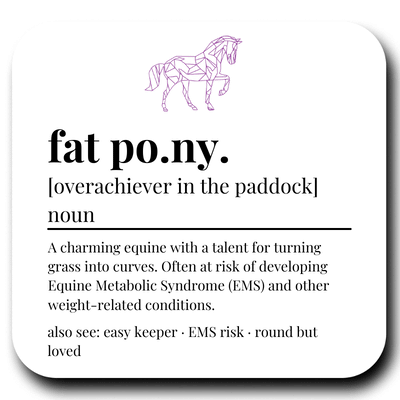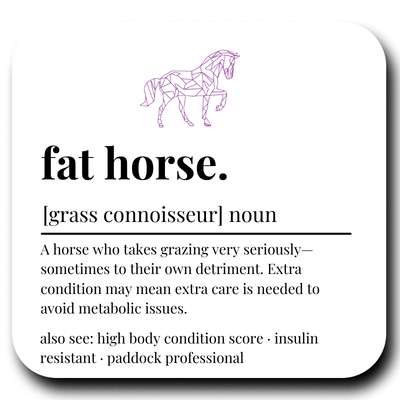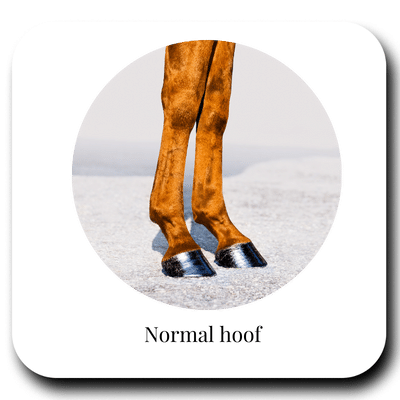Equine Metabolic Syndrome (EMS)
Equine Metabolic Syndrome (EMS) is a common condition in horses and ponies that affects how their bodies handle insulin. The main feature of EMS is insulin dysregulation, where the body overproduces insulin or doesn’t respond to it properly. This puts horses at a much higher risk for laminitis, a painful hoof disease.
Other signs of EMS may include obesity (especially fat deposits on the neck or tailhead), lethargy, and a tendency to gain weight easily. EMS is usually managed through diet changes, weight control, and regular exercise to help improve insulin sensitivity and reduce the risk of laminitis.
Equine Metabolic Syndrome (EMS) and Diabetes – What’s the connection?
EMS in horses is similar in some ways to Type 2 diabetes in people. In both cases, the body has problems using insulin, the hormone that helps control blood sugar levels.
- In people with Type 2 diabetes, the body either doesn’t make enough insulin or doesn’t respond to it properly. This leads to high blood sugar, which can cause serious health issues over time.
- In horses with EMS, the body becomes less sensitive to insulin (called insulin dysregulation). This causes the horse’s body to release more insulin than normal, which can lead to laminitis, a painful hoof condition.
Similarities between EMS and Type 2 Diabetes:
- Both involve insulin resistance (the body not responding well to insulin).
- Both are often linked to being overweight.
- Both require diet and lifestyle changes to manage.
- Both can lead to serious health problems if not treated early.
While EMS isn’t exactly the same as diabetes, understanding diabetes in people can help horse owners better manage EMS in their animals.
Commonality of EMS
While precise global prevalence rates are not well-documented on EMS, available studies provide insight into its occurrence in various regions:
- United Kingdom: Research indicates that over 30% of horses are overweight or obese, conditions closely linked to EMS (Manfredi, J et al 2023).
- Canada: Similar to the UK, studies have found that over 30% of horses are overweight or obese, suggesting a significant at-risk population for EMS (Manfredi, J et al 2023).
- United States: The prevalence of equine obesity, a major risk factor for EMS, is reported to be between 19% and 40% in domesticated horse populations Morgan R et al (2015).
These figures highlight that a substantial portion of the equine population in these regions is at risk for developing EMS. However, comprehensive data from other global regions are limited, underscoring the need for further research to accurately determine EMS prevalence worldwide.
Copyright Bova UK
Insulin is a hormone made by the pancreas. Its main job is to help move sugar (glucose) from the bloodstream into the body’s cells, where it’s used for energy.
After a horse eats, sugar levels in the blood rise. In response, the body releases insulin to help control those sugar levels. It’s like a key that unlocks the cell doors, allowing sugar to go in and be used or stored.
Keeping insulin levels in balance is key to maintaining a healthy horse!
What is Insulin dysregulation?
Insulin dysregulation means the horse’s body isn’t handling insulin and blood sugar (glucose) properly. This can happen in a few different ways:
- The horse may have high insulin levels even when resting.
- Insulin may spike too high after eating or after a sugar test.
- The horse’s body may not respond well to insulin, a condition known as insulin resistance.
High insulin levels (called hyperinsulinemia) usually happen when the pancreas makes too much insulin. This can be caused by:
- Eating feeds high in sugar and starch (non-structural carbohydrates or NSC)
- Certain gut hormones that tell the body to release more insulin after eating
Sometimes, the liver doesn’t clear out insulin from the blood fast enough, which can also lead to high insulin levels.
Insulin resistance means the horse’s tissues (like muscles and fat) don’t react the way they should to insulin. So, the body makes even more insulin to try to keep blood sugar in balance.
Hyperinsulinemia-Associated Laminitis (HAL) is the most common type of laminitis in horses and ponies—seen in over 90% of cases. It has replaced older terms like pasture-associated laminitis and endocrine-related laminitis.
HAL can develop slowly and may not be obvious at first. Over time, it often becomes a long-term issue, with repeated bouts of mild to severe lameness. It starts with damage and stretching in the sensitive tissues inside the hoof (called the digital lamellae), caused by high insulin levels in the blood (hyperinsulinemia). This early damage might not be noticed right away, but it usually leads to clear signs of laminitis later on.
HAL is different from other types of laminitis, such as those caused by infections (sepsis) or from putting too much weight on one leg (supporting-limb laminitis).
The exact cause of HAL is still being studied, but it seems to involve insulin mistakenly triggering certain cell receptors (called IGF-1 receptors) in the hoof, which may lead to tissue damage.
Risk Factors
Several factors can increase a horse’s susceptibility to Equine Metabolic Syndrome (EMS), a condition that affects insulin regulation and increases the risk of laminitis. While genetics and age play a role, environmental factors, diet, and obesity are major contributors to the development of EMS. Understanding these risk factors is crucial for preventing and managing the condition.
Breed and Genetics
Certain breeds are more prone to developing EMS. Ponies, Iberian breeds (such as Andalusians), gaited breeds (like Saddlebreds and Paso Finos), Miniature horses, Arabians, and Warmbloods are all at a higher risk. While there are some genetic markers linked to EMS, the condition is complex, involving multiple genetic factors combined with environmental influences. This means that EMS is often manageable, and interventions such as dietary management and exercise can significantly help reduce its impact.
Age
Age is an important risk factor for EMS. Horses over the age of 5 years are more likely to develop the condition, and yearly testing is recommended for horses at risk as they get older. Early detection allows for better management and reduces the risk of complications like laminitis.
Obesity and Body Condition
Obesity is one of the most significant risk factors for EMS. Horses carrying excess weight, especially in the form of regional fat deposits (such as around the neck, shoulders, and tailhead), are more likely to develop insulin resistance. Though obesity is a known risk factor, non-obese horses can still develop EMS, meaning regular monitoring is important for all horses, not just those that are overweight.
Diet and Non-Structural Carbohydrates (NSC)
Horses on high-NSC diets, such as those with a high intake of fresh grass, especially during spring and autumn when sugar levels are higher, are more likely to develop EMS. NSC-rich diets, particularly those that include high amounts of grain or rich pasture, can contribute to insulin resistance. Low-sugar, high-fibre diets are crucial in reducing the risk of EMS and maintaining stable insulin levels.
PPID (Cushing’s Disease)
Horses with PPID, are more likely to develop EMS. The link between PPID and EMS is not fully understood, but the presence of PPID can worsen insulin dysregulation and increase the risk of laminitis. Therefore, horses diagnosed with PPID should be monitored closely for signs of EMS, and testing for EMS is strongly recommended in these cases.


Signs of EMS



Obesity and its link to Equine Metabolic Syndrome (EMS)
Obesity, whether it’s general (overall body fat) or regional (fat deposits in certain areas like the neck or tailhead), can make insulin dysregulation (ID) worse, which is a key part of Equine Metabolic Syndrome (EMS). However, research has shown that the connection between obesity and ID isn’t always consistent.
This means that not all obese horses have EMS, and not all horses with EMS are obese. Because of this, it’s important to test for insulin problems even in horses that look to be a healthy weight—especially if they’re at risk for laminitis or show other signs of EMS.
In short: obesity can raise the risk, but it’s not the only sign of EMS. Regular monitoring and early testing are key to managing this condition effectively.
Diagnostic Tests for Equine Metabolic Syndrome (EMS)
Several tests are available to assess insulin dysregulation (ID) in horses. These can be categorised into dynamic tests that evaluate insulin response and resting tests that provide baseline insulin measurements.
Dynamic Tests
Oral Sugar Test (OST)
The horse is given a measured amount of sugar (like corn syrup), and blood samples are taken before and after to see how the body responds.
These tests help detect insulin dysregulation (ID) early, even before signs like laminitis appear.
Insulin Tolerance Test (ITT) – Evaluates tissue insulin resistance using a glucose reduction response.
Pros: No fasting required, results available quickly via a glucometer.
Cons: Higher cost due to insulin use, slight risk of hypoglycemia (low blood sugar) requiring monitoring.
Resting (Basal) Tests
Resting Insulin Concentration – A single blood sample taken in the fed state (hay or pasture, no grain) to detect hyperinsulinemia. Often used as a first step, but if normal, a dynamic test is needed.
Resting Blood Glucose Concentration – Helps identify diabetes mellitus, which is rare but more likely in EMS or PPID cases.
Other Tests
Post-Grazing Insulin Test – Measures insulin levels after the horse has eaten to assess laminitis risk under current dietary conditions.
Glycemic Pellet Challenge – A new commercial product under development that measures glucose and insulin response after feeding a standardised pellet meal.
For more details on EMS diagnostics, refer to the Equine Endocrinology Group’s latest guidelines: Final Oct. 2024 EEG EMS ID Recommendations
Management
Managing EMS requires a comprehensive approach that includes dietary control, structured exercise, appropriate turnout, and environmental enrichment. The goal is to reduce obesity, improve insulin sensitivity, and lower the risk of laminitis through targeted management strategies.
Non-Medical Management of EMS
Managing EMS requires a comprehensive approach that includes dietary control, structured exercise, appropriate turnout, and environmental enrichment. The goal is to reduce obesity (if obese), improve insulin sensitivity, and lower the risk of laminitis through targeted management strategies.
Diet and Forage Management
Horses with EMS require a low-sugar, high-fibre diet to prevent weight gain and minimise insulin spikes. Restricted grazing is essential, particularly during high-risk periods in spring and autumn when grass sugar levels are elevated. Strategies such as grazing muzzles can allow for turnout while reducing intake, and turnout should be on carefully managed pasture or track systems to encourage movement.
Forage should consist of low-sugar hay, which can be soaked in cold water for one hour to reduce the water-soluble carbohydrates. Mixing hay with straw can help reduce calorie intake while maintaining fibre levels. To mimic natural foraging behaviour and prevent overeating, slow feeders, trickle nets, small-holed hay nets, double nets, and hiding forage can encourage horses to eat more slowly and keep them engaged throughout the day.
Exercise and Weight Management
Regular exercise is critical in improving insulin sensitivity and preventing obesity in EMS horses. Daily movement is ideal, with a combination of lunging, long-reining, hacking, and turnout helping to keep metabolism active. A track system can naturally increase movement, as horses are encouraged to walk between feeding and water stations.
For horses at risk of laminitis, low-impact exercise such as walking or trotting should be prioritised, gradually increasing intensity as fitness improves. Strategic placement of hay and water in the field can further encourage movement and prevent long periods of inactivity.
Field and Turnout Management
Turnout must be carefully controlled to prevent excessive grass consumption. The Equicentral system, which allows horses to rotate between different areas while minimising overgrazing, can be beneficial for EMS horses. Rugging should be minimised in winter to allow natural calorie burning.
Providing playful companions in turnout can encourage natural exercise and movement. Scratch and groom stations add enrichment, reducing stress levels, which can influence hormonal balance and metabolic function.
Hoof Care and Laminitis Prevention
Horses with EMS are at high risk of laminitis, so regular hoof care is essential. Frequent trims can prevent abnormal hoof growth that may worsen lameness. Radiographs are recommended in asymptomatic cases to identify structural changes and monitor at-risk cases.
Enrichment and Mental Well-being
Managing EMS isn’t just about diet and exercise—it’s also about keeping horses mentally stimulated. Horses with EMS often have restricted diets, which can lead to frustration or stress. Using slow feeders, trickle nets, or hiding forage around their environment can help mimic natural foraging behaviours.
By combining proper diet, controlled grazing, structured exercise, environmental management, and enrichment, owners can effectively manage EMS, reducing the risk of complications while promoting long-term health and well-being.
Body Condition Scoring (BCS) for Horses
BCS is a valuable tool for assessing a horse’s overall health and weight. It helps ensure that horses are not underweight, overweight, or at risk for conditions like EMS or laminitis. Body condition scoring is especially important when managing horses with metabolic disorders, as their weight and fat levels can have significant impacts on their health.
Why We Use Body Condition Scoring
BCS provides a practical way to monitor changes in a horse’s fat levels and body condition over time. By scoring a horse’s body condition, owners and veterinary surgeons can determine if the horse is too thin, too heavy, or at an ideal weight. This helps manage the horse’s diet, exercise, and overall care, particularly for horses with EMS, where excess weight and fat can worsen insulin dysregulation and increase the risk of laminitis.
It can also help identify obesity, which is a significant risk factor for EMS. Regularly assessing BCS allows for early intervention in cases of weight gain or loss, ensuring horses maintain an appropriate weight for their health.
How We Do It
There are two primary scoring systems used to assess a horse’s body condition: the Henneke system and the Carroll and Huntington system.
Henneke Body Condition Scoring System
The Henneke system is one of the most widely used methods for evaluating body condition. It scores horses on a scale from 1 to 9, with the following definitions:
- 1 = Extremely thin (emaciated, bones visible)
- 5 = Ideal weight (ribs cannot be seen but easily felt)
- 9 = Obese (excessive fat, heavy cresty neck, fat around trailhead)
The Henneke scale focuses on assessing fat cover in areas such as the neck, withers, back, ribs, tailhead, and shoulders. A score of 4 to 6 indicates a healthy weight for most horses, with 5 being ideal.
Carroll and Huntington Body Condition Scoring System
The Carroll and Huntington system is a simpler, easier-to-use method, especially for those not familiar with fat scoring. This system uses a scale of 1 to 5, making it more accessible for everyday use by owners and caregivers.
- 1 = Very thin (ribs and bones prominent, no fat cover)
- 2 = Thin (ribs visible but the horse still has some fat cover)
- 3 = Moderate (ribs not visible but can be felt, no excessive fat)
- 4 = Good (slightly covered ribs, smooth fat over body)
- 5 = Fat (visible fat deposits, ribs cannot be felt)
This system focuses more on overall appearance and fat cover in key areas like the neck, withers, ribs, and tailhead, making it easier for non-professionals to assess a horse’s condition. It’s especially useful for horses that don’t have extreme fat deposits but need regular monitoring.
Key Areas to Assess
When assessing body condition, the following areas should be evaluated:
- Ribs: Ribs should be easily felt but not visible. Excess fat around the ribs can indicate obesity.
- Neck: A cresty neck may indicate excessive fat, particularly in EMS horses.
- Withers and back: These areas should appear smooth, not rounded or bulging.
- Tailhead: Excess fat around the tailhead can signal obesity and is a key area for scoring.
- Shoulders: These should be well-defined and not overly rounded with fat.
Regularly monitoring BCS provides early detection of any changes in a horse’s weight or fat levels, allowing for timely interventions in diet and management practices. This helps ensure that the horse remains in optimal health and reduces the risk of complications associated with metabolic disorders.
Advice specific for donkeys is available from The Donkey Sanctuary.
References:
- Morgan R, Keen J, McGowan C. Equine metabolic syndrome. Vet Rec. 2015 Aug 15;177(7):173-9. doi: 10.1136/vr.103226. PMID: 26273009; PMCID: PMC4552932.
- Manfredi, J. M., Jacob, S., & Norton, E. (2023). A one-health lens offers new perspectives on the importance of endocrine disorders in the equine athlete. Journal of the American Veterinary Medical Association, 261(2), 153-164. Retrieved Mar 21, 2025, from https://doi.org/10.2460/javma.22.11.0485
- Recommendations for the diagnosis and management of Equine Metabolic Syndrome (EMS) and Insulin Dysregulation, 2024. Available online: Equine Endocrinology Group [accessed 21/03/2025]
- British Horse Society, n.d. Equine Metabolic Syndrome. [online] Available at: https://www.bhs.org.uk/horse-care-and-welfare/health-care-management/horse-health/equine-diseases/equine-metabolic-syndrome/ [Accessed 28 March 2025].
Hyperinsulinemia-Associated Laminitis (HAL), a focus on the foot (2025)


